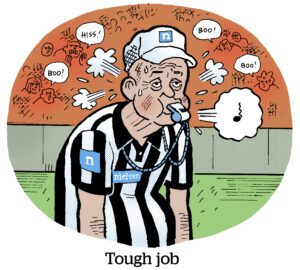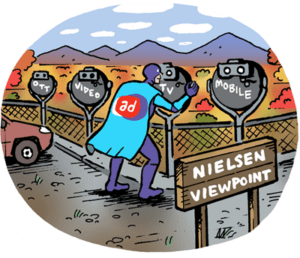The TV currency strife continues, and Nielsen is looking more and more like the black sheep.
The ratings giant has been trying to stay relevant with promises to add big data to its panel-based measurement via Nielsen ONE, in a nod of recognition to an industry preference.
But just days after Nielsen won back accreditation for its panel-based national ratings, it stuck its nose in the air and declared its disapproval of the joint industry committee’s (JIC) new video currency standards, which favor big data over panels.
The cheese stands alone
In a letter defending panels to OpenAP last week, CEO of Nielsen Audience Measurement Karthik Rao wrote that Nielsen will not be joining the group until “fundamental issues” are resolved. (OpenAP is the ad platform behind the JIC.)
Nielsen is also back to reminding everyone that it’s the only TV measurement vendor with accreditation from the Media Rating Council (MRC), thank you very much.
OpenAP’s response to Nielsen states that the JIC created its standards based on industrywide collaboration and feedback – a pointed reminder that, unlike Nielsen, the JIC is backed by industry approval.
TL;DR: Panels are out – get over it.
And so goes the tug-of-war between Nielsen and everyone else.
Panels vs. big data
When Nielsen lost its MRC accreditation for national and local ratings in 2021, programmers blamed the inability of panels to properly count audiences across screens.
Once the anti-panel fervor settled down, the industry acknowledged that panels do have value, depending on the situation. Panels are pretty good, for example, at filling in gaps within big data, such as personifying individual viewers rather than just households. Hence the birth of what the industry calls “calibration panels.”
Be that as it may, the consensus among most broadcasters is that panels should be used for research and post-campaign measurement only, not as the basis of currency for buying and selling TV ads. (Related: TV measurement vs. TV currency.)
The JIC makes this clear in its initial standards for currencies, noting that vendors should only use impression-based measurement with limited reliance on panels, which are too small. Under the JIC’s requirements, currencies that make campaign projections “representing less than 10% of the population” must disclose that fact. (Say Nielsen without saying Nielsen.)
Unsurprisingly, Nielsen pushed back against that requirement.
The assumption that big data is always more effective than panels is “not supported with statistical evidence,” Rao wrote to OpenAP.
But even Nielsen agrees that panels work best in tandem with big data. Pete Doe, the company’s chief research officer, shared some stats onstage at an Advertising Research Foundation (ARF) summit on Tuesday that underscore this point.
Compared with panels alone, Doe sad, “calibration with big data [gives] a much more logical and sensible view of audiences.”
Watch your accredit score
Still, Nielsen and the JIC continue to butt heads, and their disagreement goes beyond arguing about the finer points of panels versus big data.
Nielsen also called out the JIC for undervaluing third-party verification by not requiring measurement vendors to get MRC accreditation as part of its currency certification process, thereby “conflating accreditation with certification.”
“We do not agree simply ‘seeking’ MRC accreditation is an acceptable standard,” Rao wrote.
To be fair, Nielsen has reason to be salty about the JIC essentially bypassing MRC accreditation in certifying currencies. Programmers and agencies spent over a year dragging Nielsen through the mud for losing something that its present rivals aren’t even required to have. Talk about double standards (pun intended).
It’s not that the TV ad industry doesn’t care about MRC accreditation anymore, but rather that time is of the essence. Sellers and buyers are now more concerned with getting new currencies ready for transaction in time for next year’s upfronts, and they don’t want the accreditation process slowing them down.
Although the JIC will check currencies for data quality, such as whether they’re using data that’s nationally representative and includes at least two years of historic viewership information, it won’t require vendors to go through an intensive third-party audit to get JIC certification.
For now, the industry is prioritizing the urgency to transact on multiple effective currencies as soon as humanly possible.
What I want to know is: Will Nielsen and the JIC ever be able to bury the hatchet, or will the gulf between them continue to widen?
“Nielsen and the JIC are in conversation,” Doe said on Tuesday at the ARF event. “We’re certainly not turning away [from the JIC].”
Guess we’ll see the teamwork happen when it happens.
Let me know what you think. Hit me up at [email protected].

















